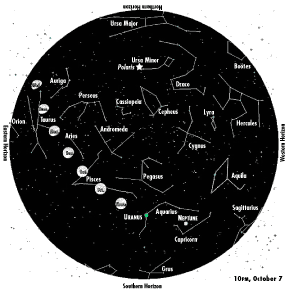 |
Sky Watch
by J. Alex Knoll
|
A Mutual Attraction
The moon’s tug keeps things moving on earth
Mia culpa. Perhaps you caught an error in my column on last month’s Harvest Moon, the full moon closest to fall equinox, which means the full moon of October 6 this year.
Although Harvest Moon traditionally falls in September, the 281/2-day lunar cycle doesn’t always sync with the 30-, 31- and 28-day months of our Gregorian calendar. So this year’s true Harvest Moon falls in October. Likewise, the Hunter’s Moon and the moons of the following seven months fall later than usual, until the blue moon of June realigns all.
Even so, this Harvest Moon will pale in comparison to September’s contender, which followed a westward arc almost twice as close to the horizon. No surprise, as the moon on October 4 hovered over earth’s meridian, its highest point due south. The closer the full moon to the horizon, the more the tricks to the eye that make it appear overly large and colorful.
Tricks aside, Friday’s full moon pulls hard on the earth, making for extreme high tides with swift ebb and flow. It all comes down to gravity, one of the weakest forces in physics. The earth, the sun and the moon all pull at one another. The sun’s gravity keeps earth in orbit; Earth’s pull keeps the moon in orbit, while the moon’s own gravity counters, keeping it from crashing into earth.
That lunar tug causes our tides, literally bending and bulging earth’s crust, subtly, but enough to cause bodies of water to rise and fall. Coupled with the pull from the sun, which stands dead-opposite the full moon nearest equinox, that’s a lot of force to bear. Both earth and moon are feeling the effects.
Earth’s stronger force long ago slowed the moon’s rotation so that it has aligned with its orbit around earth, thus always showing the same face. The moon, however, is no weakling, as its tug slows our own orbit by .0016 seconds every century, so that far in the future, the two will remain face to face thereafter.